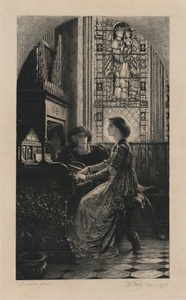| Method | Etching |
| Artist | Charles Albert Waltner after Sir Frank Dicksee |
| Published | [Thomas Agnew 6th December 1879] |
| Dimensions | Image 405 x 235 mm, Plate 517 x 315 mm, Sheet 610 x 417 mm |
| Notes |
Printed artist and engraver signatures in plate. Plate declared to the Printseller's Association December 6th, 1879, with their blind stamp lower left. The painting upon which this etching is based is now in the Tate collection. One of Dicksee's most popular works, Harmony depicts a young man gazing adoringly at a young woman playing the organ. The model for the woman was Hilda Spencer, an art student at Queens College, Harley Street, where Dicksee taught. During his studentship at the Royal Academy Schools, Dicksee joined the Langham Sketching Club. Encouraged one evening by the sketch he had produced on the theme of music, Dicksee worked on an oil painting of the same composition. In 1877, when still only twenty four years of age, the painting was exhibited at the Royal Academy with the title Harmony. The medieval setting of the painting clearly reflects the influence of Pre-Raphaelite art and design. The furniture in particular, is reminiscent of the pieces that were produced at the time by William Morris. Charles Albert Waltner (1846 - 1925) was one of the most prolific reproductive engravers of his time. Born in Paris, he studied art under Louis Pierre Henriquel-Dupont and Jean-Leon Gerome. In 1868 he was awarded a scholarship to Rome, and made his debut at the Paris Salon two years later. Mainly engraving for the Journal de Beaux Artes and L'Art, Waltner's work was popular in both France and Britain. An admirer of his expressive style, the British Pre-Raphaelite founder Sir John Everett Millais, actively sought Waltner to reproduce five of his compositions as etchings, including The Widow's Mite. In 1882 the French government appointed him a chevalier of the Legion d'honneur, and in 1900, he received the Grand Prize for his art from the Exposition Universelle. Sir Francis Bernard Dicksee KCVO (1853 - 1928) was an English painter and illustrator, best known for his dramatic historical and legendary scenes. Although not a member of the Pre-Raphaelite Brotherhood many of Dicksee's paintings can be considered Pre-Raphaelite in style. He was also a noted portrait painter, which helped to bring him success in his own time. The son of the artist Thomas Dicksee, Frank and his siblings Herbert and Margaret, were all taught to paint from an early age. In 1870, Dicksee enrolled in the Royal Academy Schools and achieved early success. He was elected to the Academy in 1891, and became its President in 1924. He was knighted in 1925, and named to the Royal Victorian Order by King George V in 1927. Thomas Agnew and Sons were a British publishing firm established in Manchester in 1817 by Thomas Agnew and Vittore Zanetti. Although primarily a print publishers, the firm later became best-known as a dealer in modern and Old Master paintings. The London branch was established in 1860. After Agnew's retirement in 1861, the business was run from 1861 until 1895 by William Agnew. Condition: Even time toning to printed area. Professionally repaired pin holes to area below image. |
| Framing | mounted |
| Price | £750.00 |
| Stock ID | 52217 |

